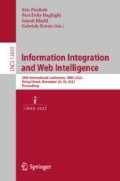Abstract
Telepresence robots (TPRs) are becoming increasingly popular in education as they support social presence (an important component of human communication) of teachers and students. This paper presents the results of a study that explored the challenges of using a telepresence robot in a higher education STEAM workshop through the eyes of a teacher, telepresence robot mediated persons and physically present students. We identified crucial aspects that need to be addressed when involving telepresence robots in the hybrid teaching and learning process. The perspectives of using TPRs were mostly positive. However, technical support and changes in classroom practices are needed for successful use of TPRs in the teaching and learning process. Although TPRs enable greater social presence, the technology is still novel and its successful implementation requires more research, focusing on applying effective pedagogical design principles and adapting the environment accordingly to the conditions necessary for the successful operation of the TPRs. The TPR’s passenger option did not yield positive results in our research. This caused the participants to become detached from what was happening in the classroom, feel unable to control the situation, and supported social presence even less than using teleconference-based distance learning methods.
Access this chapter
Tax calculation will be finalised at checkout
Purchases are for personal use only
References
Cain, W., Bell, J., Cheng, C.: Implementing robotic telepresence in a synchronous hybrid course. In: 2016 IEEE 16th International Conference on Advanced Learning Technologies (ICALT) (2016)
Means, B., Toyama, Y., Murphy, R., Bakia, M., Jones, K.: Evaluation of evidence-based practices in online learning: a meta-analysis and review of online learning studies. U.S. Department of Education (2010)
Gleason, B., Greenhow, C.: Hybrid education: the potential of teaching and learning with robot-mediated communication. Online Learn. J. 21(4), 159–176 (2017)
Bell, J.: Telepresence robots give distance students their own seat at the table. EdTech: Technology Solutions That Strive Education. EdTech (2017). https://edtechmagazine.com/higher/article/2017/03/telepresence-robots-give-distance-students-their-own-seat-table
El-Gayar, O., Chen, K., Tandekar, K.: Multimedia interactivity on the Internet. In: Pagani, M. (eds.) Encyclopedia of Multimedia Technology and Networking. Idea Group Inc., Hershey (2005)
Tuli, T.B., Terefe, T.O., Rashid, M.M.U.: Telepresence mobile robots design and control for social interaction. Int. J. Soc. Robot. 13(5), 877–886 (2021)
Vaughn, J., Shaw, R.J., Molloy, M.A.: A telehealth case study: the use of telepresence robot for delivering integrated clinical care. J. Am. Psychiatr. Nurses Assoc. 21(6), 431–432 (2015)
Leoste, J., Virkus, S., Talisainen, A., Tammemäe, K., Kangur, K., Petriashvili, I.: Higher education personnel’s perceptions about telepresence robots. In: Computational Intelligence Advances in Educational Robotics (to be published, 2022)
Conti, D., Di Nuovo, S., Buono, S., Di Nuovo, A.: Robots in education and care of children with developmental disabilities: a study on acceptance by experienced and future professionals. Int. J. Soc. Robot. 9(1), 51–62 (2017)
Reis, A., Martins, M., Martins, P., Sousa, J., Barroso, J.: Telepresence robots in the classroom: the state-of-the-art and a proposal for a telepresence service for higher education. In: Tsitouridou, M., A. Diniz, J., Mikropoulos, T.A. (eds.) TECH-EDU 2018. CCIS, vol. 993, pp. 539–550. Springer, Cham (2019). https://doi.org/10.1007/978-3-030-20954-4_41
Davey, R.: Telepresence robotics: an overview, AZO Robotics (2021). https://www.azorobotics.com/Article.aspx?ArticleID=414
Hickenbottom, K.G.: Almost Like Being There: Embodiment, Social Presence, and Engagement Using Telepresence Robots in Blended Courses (Doctoral dissertation, Seattle Pacific University) (2022)
Adalgeirsson, S.O., Breazeal, C.: MeBot: a robotic platform for socially embodied telepresence. In: 2010 5th ACM/IEEE International Conference on Human-Robot Interaction (HRI) (2010)
Garrison, D.R.: Online community of inquiry review: Social, cognitive, and teaching presence issues. J. Asynchronous Learn. Networks 11(1), 61–72 (2007)
Shin, K.W.C., Han, J.: Children's perceptions of and interactions with a telepresence robot. In: 2016 11th ACM/IEEE International Conference on Human-Robot Interaction (HRI) (2016)
Keller, L., Pfeffel, K., Huffstadt, K., Müller, N.H.: Telepresence robots and their impact on human-human interaction. In: Zaphiris, P., Ioannou, A. (eds.) HCII 2020. LNCS, vol. 12206, pp. 448–463. Springer, Cham (2020). https://doi.org/10.1007/978-3-030-50506-6_31
Newhart, V.A., Warschauer, M., Sender, L.: Virtual inclusion via telepresence robots in the classroom: an exploratory case study. Int. J. Technol. Learn. 23(4), 9–25 (2016). https://doi.org/10.18848/2327-0144/CGP/v23i04/9-25
Wernbacher, T., et al.: Trine: telepresence robots in education. In: Proceedings of INTED2022 Conference (2022). https://doi.org/10.21125/inted.2022.1653
Schouten, A.P., Portegies, T.C., Withuis, I., Willemsen, L.M., Mazerant-Dubois, K.: Robomorphism: examining the effects of telepresence robots on between-student cooperation. Comput. Hum. Behav. 126, 106980 (2022)
Cheung, D., Dykeman, T., Fell, C.: Using telepresence robots to support students facing adversity. Educause Rev. (2018). https://er.educause.edu/articles/2018/6/using-telepresence-robots-to-support-students-facing-adversity
Karypi, S.: Educational robotics application in primary and secondary education. A challenge for the Greek teachers’ society. J. Contemporary Educ. Theory Res. 2(1), 9–14 (2018)
Khanlari, A.: Teachers’ perceptions of using robotics in primary/elementary schools in Newfoundland and Labrador (Doctoral dissertation, Memorial University of Newfoundland) (2014)
Miles, M.B., Huberman, A.M., Saldaña, J.: Qualitative Data Analysis: A Methods Sourcebook. Sage Publications, Los Angeles (2018)
Hall, E.: The Hidden Dimension. Anchor Books Editions, New York (1966)
Leoste, J., Heidmets, M., Ley, T., Stepanova, J.: Classroom innovation becoming sustainable: a study of technological innovation adoption by Estonian primary school teachers. Interact. Des. Archit. J. 47, 144–166 (2021). https://doi.org/10.55612/s-5002-047-008
Author information
Authors and Affiliations
Corresponding author
Editor information
Editors and Affiliations
Rights and permissions
Copyright information
© 2022 The Author(s), under exclusive license to Springer Nature Switzerland AG
About this paper
Cite this paper
Leoste, J., Virkus, S., Kasuk, T., Talisainen, A., Kangur, K., Tolmos, P. (2022). Aspects of Using Telepresence Robot in a Higher Education STEAM Workshop. In: Pardede, E., Delir Haghighi, P., Khalil, I., Kotsis, G. (eds) Information Integration and Web Intelligence. iiWAS 2022. Lecture Notes in Computer Science, vol 13635. Springer, Cham. https://doi.org/10.1007/978-3-031-21047-1_2
Download citation
DOI: https://doi.org/10.1007/978-3-031-21047-1_2
Published:
Publisher Name: Springer, Cham
Print ISBN: 978-3-031-21046-4
Online ISBN: 978-3-031-21047-1
eBook Packages: Computer ScienceComputer Science (R0)

